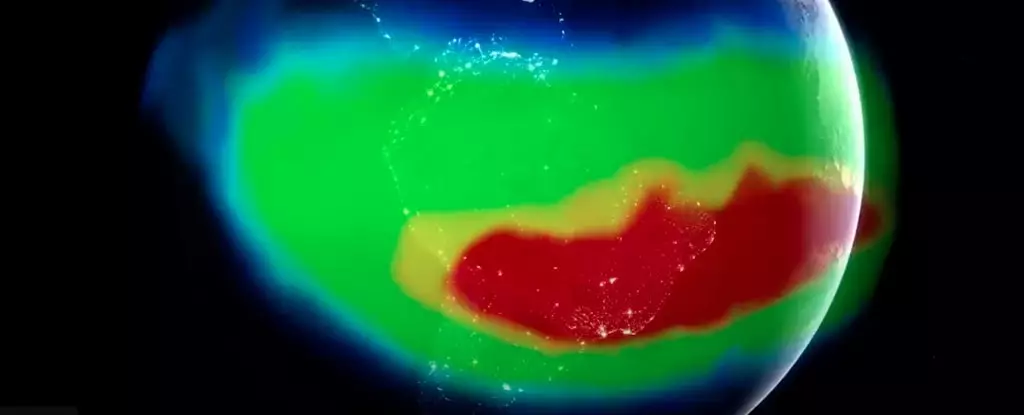Earth’s magnetic field acts as an invisible force field, shielding our planet from harmful solar and cosmic radiation. Yet, embedded within this protective barrier lies a perplexing and concerning feature: the South Atlantic Anomaly (SAA). This vast region, stretching from South America toward southwest Africa, is characterized by a significant dip in magnetic intensity—a phenomenon that has caught the curiosity and concern of scientists and space agencies worldwide. Unlike the static magnetic shield we often imagine, Earth’s magnetosphere is a dynamic, ever-changing entity, and the SAA stands as a testament to its complexity. Its existence raises questions about the stability of our planet’s magnetic system and potential risks to both space-based technologies and our understanding of planetary processes.
The Dangers for Spacecraft and Satellites
While the SAA has minimal direct impact on life on Earth, its effects in the realm of space are profound. Satellites orbiting within low-Earth orbit regularly pass through this weakened magnetic zone. During these traversals, spacecraft are exposed to a surge of high-energy charged particles emanating from the Sun, which can cause unforeseen malfunctions or even permanent damage to electronic systems. NASA’s satellites are particularly vulnerable, prompting the agency to implement preventive measures like shutting down vulnerable systems prior to entering the anomaly zone.
The seriousness of these threats is often understated, but the potential for data loss and device failure makes the SAA a focal point for space operations. As satellites become more integral to communication, navigation, and weather forecasting, understanding and mitigating these risks is crucial for the integrity of vital infrastructure. NASA’s vigilant tracking of the anomaly isn’t merely an act of curiosity but a necessity for safeguarding technological investments in space. It also underscores a broader concern that our reliance on sensitive space-borne systems makes us vulnerable if we don’t fully comprehend the anomaly’s behavior.
Deciphering the Geophysical Underpinnings
The roots of the South Atlantic Anomaly lie deep within Earth’s interior. The planet’s magnetic field is generated by the movement of molten iron and other conductive materials within the outer core, creating electrical currents that produce a magnetic shield. However, this process is far from uniform. Certain underground structures, like the African Large Low Shear Velocity Province—located roughly 2,900 kilometers beneath Africa—disrupt the flow of these currents, contributing to localized weakening of the magnetic field.
Scientists have also noted a shift in the nature of Earth’s magnetic field, driven partly by the tilt of the planet’s magnetic axis and complex interactions among various sources of magnetic flux. These interactions can produce regions of reversed polarity within the broader magnetic field, further weakening the magnetic intensity in specific zones like the SAA. Moreover, the anomaly is not static; it drifts and evolves over time, with recent research indicating it may even be splitting into two separate “cells,” each with its distinct center of low magnetic strength. Such dynamism illustrates that Earth’s magnetic past is replete with anomalies, and the current features may be part of a long-term pattern with implications we are only beginning to understand.
The Anomaly’s Evolution and Long-Term Significance
One of the most intriguing aspects of the SAA is its apparent persistence over millions of years. Studies suggest that events similar to the current anomaly have been recurrent over the past 11 million years, implying it is not a freak occurrence but a natural aspect of Earth’s magnetic behavior. This perspective reshapes how we interpret the anomaly: it’s not necessarily an indicator of an imminent pole flip but rather a regular feature in our planet’s magnetic history.
The splitting of the SAA into separate sectors and its slow drift challenge previous notions of a static magnetic field. They reveal a complex, living system that morphs over time, possibly influenced by deep-seated geophysical processes that remain poorly understood. As the anomaly continues to evolve, scientists are confronted with vital questions about the planet’s magnetic future, including the likelihood of a geomagnetic reversal—a rare event where Earth’s magnetic poles switch places—which can have profound effects on climate and biological life.
Looking Ahead: The Need for Vigilant Observation
Despite advances in geophysical research, the South Atlantic Anomaly remains a largely mysterious feature. Its slow but constant evolution suggests that continuous observation is essential to unravel its properties and assess future risks. NASA’s commitment to tracking the anomaly exemplifies this proactive approach, leveraging satellite data, cube sats, and advanced modeling to gain insights into its behavior.
Understanding the SAA isn’t merely an academic pursuit; it’s vital for future space missions, satellite safety, and our broader comprehension of Earth’s magnetic health. As technological reliance deepens, so does the importance of predicting and preparing for potential disruptions caused by the anomaly. While it may seem like an abstract geophysical curiosity at first glance, the SAA’s influence reaches down to the very fabric of our technological civilization, reminding us that planetary processes are intimately linked with our modern existence.

